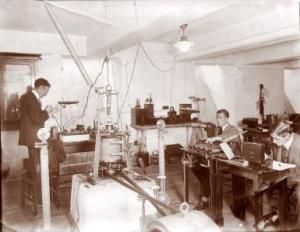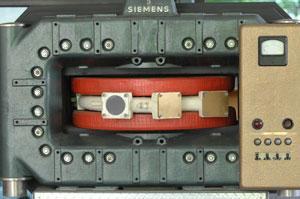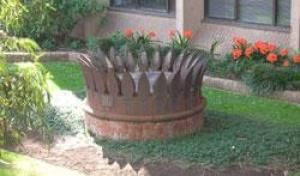History
The first lectures in physics at the University of Melbourne were taught in the 1860s originally within the Faculty of Medicine; it was then known as 'natural philosophy'.
- 1860s
The first lectures in physics, taught originally within the Faculty of Medicine.
- 1882
Department of Natural Philosophy established under Prof HM Andrew.
- 1889
Natural Philosophy building completed at a cost of 5,943 pounds.
Sir Thomas Lyle, Head of Department (1889-1914)
- 1903
The Department becomes affiliated with the Faculty of Science
- 1915
Professor Thomas Laby, Head of Department (1915-1944)

Eric Hercus, Jack Osborne and Thomas Laby in Old Physics, 1920: apparatus for the measurement of mechanical equivalent heat. - 1945
Becomes the School of Physics
It became a department in its own right in 1882 under Prof HM Andrew with the Natural Philosophy building completed soon after, in 1889, at a cost of 5,943 pounds. By 1903, the department had become affiliated with Faculty of Science and the name changed to the School of Physics in 1945, upon recommendation by the British Institute of Physics.
Dalton's atomic theory, Faraday's demonstration of electromagnetism and the multiplicity of advances in science and medicine were changing the intellectual and physical environment of society in the late 19th century. There was a strong focus on experiment and the development of equipment that could express observation quantitatively. Sir Thomas Lyle (Head: 1889-1914), set about lobbying government for funding of new facilities for the Department of Natural Philosophy, then located in what is currently known as 'Old Physics'. He made notable contributions to electrical theory and instrumentation and is most likely to have been the first man in Australia to take an X-ray photograph, having made his own X-ray tube.
Professor Thomas Laby (Head: 1915-1944), did much to advance physics research in Australia. He focused the department away from simply teaching in-service to one with true research culture. The number of the department's undergraduates expanded from 178 students in 1913 to 524 in 1920, making the School one of the strongest in the southern hemisphere at the time.

In the absence of a formal doctorate program at the University, first rate Masters graduates were encouraged to take up PhD programs overseas at Cambridge and Oxford, many supported by prestigious University '1851 scholarships'. (He himself received a DSc degree from Cambridge University in 1921).
Research strengths now included applied research related to the war effort, health and industry (radiography, gas mask, optical munitions, geophysics, atmospherics, radio, x-rays); classical physics (heat, conductivity) and the relatively 'new' areas of atomic, nuclear and particle physics. Laby set up the Australian branch of the Institute of Physics and played a major advisory role for the Commonwealth Radium Laboratory which emphasized use of X-rays and radioactivity for use in cancer research. He also set up the Optical Munitions Panel for testing and small scale production of fine optical glass and measurement instruments required for manufacturing industries. Much of the beautifully constructed early equipment can still be viewed at the Physics Museum. Laby's contributions were nationally recognized when Australia Post issued a series of commemorative stamps on Famous Australians in 1976.
- 1945
Professor Leslie Martin, Head of School (1945-1959)
- 1955
The first electronic computer in Australia installed at the School.
- 1961
Professor David Caro, Head of School (1961-1972)
- 1974
Prof Martin opens the 'new' Physics building.
- 2007
LH Martin Institute, officially launched by the Hon Julie Bishop.
Professor Leslie Martin (Head: 1945-1959), a former student of Laby's, returned to the School from the Cavendish Laboratory in Cambridge where he had been working under eminent nuclear physicist, Ernest Rutherford. He oversaw a rapidly expanding department as armed forces personnel returned to take up or finish degrees that were interrupted by the war. Originally an experimentalist in X-ray research, Martin developed interests in accelerator-based nuclear and atomic physics, acquiring two Van de Graaff accelerators, a small betatron and an electron synchrotron. He oversaw the establishment of a growing theoretical physics group under Courtney Mohr.
He also helped persuade CSIRO to give CSIRAC, the first electronic computer in Australia, to the School of Physics in 1955, thereby creating an early interest in computing and computer science. In 1974, he officially opened the 'new' Physics building at its current site which was facilitated by a $4 million grant from state and federal governments. In 2007, his namesake, the LH Martin Institute for Higher Education Leadership and Management, was officially launched by the Hon Julie Bishop. More information can be found on their website.

Professor David Caro, (Head: 1961-1972) was a brilliant lecturer and talented researcher. Along with Dr John Rouse, they were the first in the world to design a variable energy cyclotron in the late 1950s. This consolidated the research group in experimental particle and nuclear physics in Australia and was instrumental in continuing to provide the country with a talented crop of highly trained experimental physicists over the next decade. His contributions to physics, academia and society have been recognized in his award of Order of Australia and Order of the British Empire.For the department's history and information relating to Heads of School and Professorial Chairs, please refer to Faculty of Science History Compendium. More detail…
Related Publications
- A Man Ahead of His Times – TH Laby's Contribution to Australian Science by Ed Muirhead, Spectrum Publications Pty Ltd, 1996
- Leslie Martin at Melbourne: Profile of a Physics Department (1945-1959) by Ed Muirhead, School of Physics, Melbourne, 1998
- A Short History of the University of Melbourne by Stuart Macintyre, RJW Selleck, Melbourne University Press, 2003